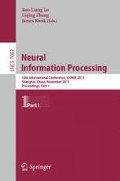Abstract
In this work, we proposed an emotional face evoked EEG signal recognition framework, within this framework the optimal statistic features were extracted from original signals according to time and space, i.e., the span and electrodes. First, the EEG signals were collected using noise suppression methods, and principal component analysis (PCA) was used to reduce dimension and information redundant of data. Then the optimal statistic features were selected and combined from different electrodes based on the classification performance. We also discussed the contribution of each time span of EEG signals in the same electrodes. Finally, experiments using Fisher, Bayes and SVM classifiers show that our methods offer the better chance for reliable classification of the EEG signal. Moreover, the conclusion is supported by physiological evidence as follows: a) the selected electrodes mainly concentrate in temporal cortex of the right hemisphere, which relates with visual according to previous psychological research; b) the selected time span shows that consciousness of the face picture has a trend from posterior brain regions to anterior brain regions.
Access this chapter
Tax calculation will be finalised at checkout
Purchases are for personal use only
Preview
Unable to display preview. Download preview PDF.
References
Schaaff, K., Schultz, T.: Towards an EEG-Based Emotion Recognizer for Humanoid Robots. In: The IEEE Inter. Symposium on Robot and Human Interactive Communication Toyama, pp. 792–796 (2009)
Furui, S., Hwang, J.: Automatic Recognition and Understanding of Spoken Languages- A First Step Toward Natural Human Machine Communication. Proc. of the IEEE 88, 1142–1165 (2000)
Cowie, R., Douglas, E., Tsapatsoulis, N., Votsis, G., Kollias, G., Fellenz, W., Taylor, J.G.: Emotion Recognition in Human Computer Interaction. IEEE Trans. Signal Processing 18, 3773–3776 (2001)
Petrantonakis, P., Hadjileontiadis, L.: Emotion Recognition from EEG Using Higher Order Crossings. IEEE Trans. Information Techonology in Biomedicine 14(2), 186–197 (2010)
Meeren, H., Heijnsbergen, C., Gelder, B.: Rapid Perceptual Integration of Facial Expression and Emotional Body Language. PNAS 102(45), 16518–16523 (2005)
Chanel, G., Karim, A., Pun, T.: Valence-Arousal Evaluation Using Physiological Signals in an Emotion Recall Paradigm. In: IEEE Inter. Conference on Systems, Man and Cybernetics, pp. 530–537 (2007)
Murugappan, M., Nagarajan, R., Yaacob, S.: Comparison of Different Wavelet Features from EEG Signals for Classifying Human Emotions. In: IEEE Symposium on Industrial Electronics & Applications, vol. 2, pp. 836–841 (2009)
Haihong, Z., Cuntai, G., Chuanchu, W.: Asynchronous P300-Based Brain-Computer Interfaces: A Computational Approach with Statistical Models. IEEE Trans. on Biomedical Engineering 55(6), 1754–1763 (2008)
Wenbo, L.: The Neural Mechanism of Facial Processing in Rapid Serial Visual Presentation (2009)
Robinson, A., Morris, J.: Is the N170 ERP Component Face Specific? Poster presented at the Meeting of the Psychonomic Society (2002)
Li, P.: An Event-Related Potential Study of Facial Expression Perception. master thesis. Hunan Normal University (2007)
Author information
Authors and Affiliations
Editor information
Editors and Affiliations
Rights and permissions
Copyright information
© 2011 Springer-Verlag Berlin Heidelberg
About this paper
Cite this paper
Duan, L. et al. (2011). An Emotional Face Evoked EEG Signal Recognition Method Based on Optimal EEG Feature and Electrodes Selection. In: Lu, BL., Zhang, L., Kwok, J. (eds) Neural Information Processing. ICONIP 2011. Lecture Notes in Computer Science, vol 7062. Springer, Berlin, Heidelberg. https://doi.org/10.1007/978-3-642-24955-6_36
Download citation
DOI: https://doi.org/10.1007/978-3-642-24955-6_36
Publisher Name: Springer, Berlin, Heidelberg
Print ISBN: 978-3-642-24954-9
Online ISBN: 978-3-642-24955-6
eBook Packages: Computer ScienceComputer Science (R0)

